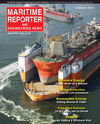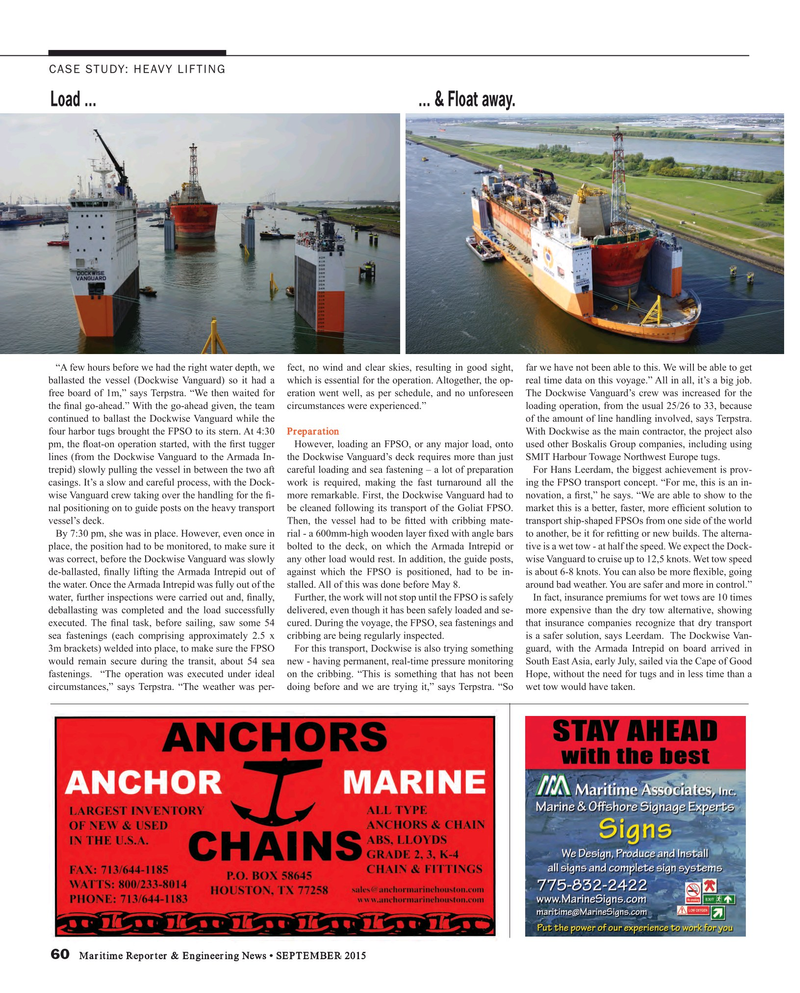
Page 60: of Maritime Reporter Magazine (September 2015)
Offshore Energy Technologies
Read this page in Pdf, Flash or Html5 edition of September 2015 Maritime Reporter Magazine
CASE STUDY: HEAVY LIFTING
Load ... ... & Float away.
“A few hours before we had the right water depth, we fect, no wind and clear skies, resulting in good sight, far we have not been able to this. We will be able to get ballasted the vessel (Dockwise Vanguard) so it had a which is essential for the operation. Altogether, the op- real time data on this voyage.” All in all, it’s a big job. free board of 1m,” says Terpstra. “We then waited for eration went well, as per schedule, and no unforeseen The Dockwise Vanguard’s crew was increased for the the ? nal go-ahead.” With the go-ahead given, the team circumstances were experienced.” loading operation, from the usual 25/26 to 33, because continued to ballast the Dockwise Vanguard while the of the amount of line handling involved, says Terpstra. four harbor tugs brought the FPSO to its stern. At 4:30 Preparation With Dockwise as the main contractor, the project also pm, the ? oat-on operation started, with the ? rst tugger However, loading an FPSO, or any major load, onto used other Boskalis Group companies, including using lines (from the Dockwise Vanguard to the Armada In- the Dockwise Vanguard’s deck requires more than just SMIT Harbour Towage Northwest Europe tugs. trepid) slowly pulling the vessel in between the two aft careful loading and sea fastening – a lot of preparation For Hans Leerdam, the biggest achievement is prov- casings. It’s a slow and careful process, with the Dock- work is required, making the fast turnaround all the ing the FPSO transport concept. “For me, this is an in- wise Vanguard crew taking over the handling for the ? - more remarkable. First, the Dockwise Vanguard had to novation, a ? rst,” he says. “We are able to show to the nal positioning on to guide posts on the heavy transport be cleaned following its transport of the Goliat FPSO. market this is a better, faster, more ef? cient solution to vessel’s deck. Then, the vessel had to be ? tted with cribbing mate- transport ship-shaped FPSOs from one side of the world
By 7:30 pm, she was in place. However, even once in rial - a 600mm-high wooden layer ? xed with angle bars to another, be it for re? tting or new builds. The alterna- place, the position had to be monitored, to make sure it bolted to the deck, on which the Armada Intrepid or tive is a wet tow - at half the speed. We expect the Dock- was correct, before the Dockwise Vanguard was slowly any other load would rest. In addition, the guide posts, wise Vanguard to cruise up to 12,5 knots. Wet tow speed de-ballasted, ? nally lifting the Armada Intrepid out of against which the FPSO is positioned, had to be in- is about 6-8 knots. You can also be more ? exible, going the water. Once the Armada Intrepid was fully out of the stalled. All of this was done before May 8. around bad weather. You are safer and more in control.” water, further inspections were carried out and, ? nally, Further, the work will not stop until the FPSO is safely In fact, insurance premiums for wet tows are 10 times deballasting was completed and the load successfully delivered, even though it has been safely loaded and se- more expensive than the dry tow alternative, showing executed. The ? nal task, before sailing, saw some 54 cured. During the voyage, the FPSO, sea fastenings and that insurance companies recognize that dry transport sea fastenings (each comprising approximately 2.5 x cribbing are being regularly inspected. is a safer solution, says Leerdam. The Dockwise Van- 3m brackets) welded into place, to make sure the FPSO For this transport, Dockwise is also trying something guard, with the Armada Intrepid on board arrived in would remain secure during the transit, about 54 sea new - having permanent, real-time pressure monitoring South East Asia, early July, sailed via the Cape of Good fastenings. “The operation was executed under ideal on the cribbing. “This is something that has not been Hope, without the need for tugs and in less time than a circumstances,” says Terpstra. “The weather was per- doing before and we are trying it,” says Terpstra. “So wet tow would have taken.
60 Maritime Reporter & Engineering News • SEPTEMBER 2015
MR #9 (58-65).indd 60 MR #9 (58-65).indd 60 9/9/2015 10:26:18 AM9/9/2015 10:26:18 AM

 59
59

 61
61
